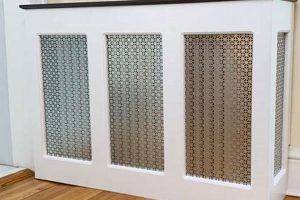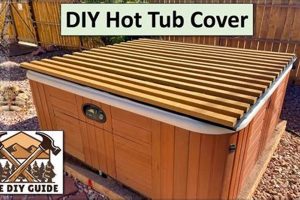Creating forms for shaping and setting concrete using readily available materials and personal labor represents a cost-effective method for producing custom concrete elements. This approach allows individuals to fashion unique pavers, planters, or decorative features for residential or commercial applications. The process typically involves constructing a negative space into which wet concrete is poured, allowed to cure, and then removed, leaving behind the desired concrete shape. A simple example would be constructing a wooden frame to create a rectangular concrete stepping stone.
The benefits of fabricating these forms include significant cost savings compared to purchasing pre-cast concrete items. Furthermore, this practice empowers individuals to create custom designs and sizes tailored to specific project requirements. Historically, the ability to mold concrete has been central to architectural innovation, and contemporary do-it-yourself applications continue this tradition by democratizing access to concrete design.
The subsequent sections will delve into the various materials suitable for form construction, techniques for achieving desired textures and finishes, and essential considerations for ensuring structural integrity and durability of the finished concrete product. These elements are crucial for successfully creating durable and aesthetically pleasing features.
Concrete Form Creation
Successfully fabricating concrete forms requires meticulous planning and execution. The following tips provide guidance on critical aspects of the process, ensuring a structurally sound and aesthetically pleasing outcome.
Tip 1: Material Selection: Choose form materials appropriate for the scale and complexity of the project. Wood, melamine, and rigid plastics offer varying degrees of durability and ease of use. Consider the number of reuses anticipated, as this directly impacts material selection.
Tip 2: Accurate Dimensions: Precise measurements are paramount. Discrepancies in form dimensions translate directly to inaccuracies in the final concrete product. Double-check all measurements before cutting and assembling the form.
Tip 3: Watertight Seals: Ensure the form is completely sealed to prevent concrete slurry from leaking. Apply silicone caulk to all seams and joints. Leakage not only results in material waste but also weakens the concrete structure.
Tip 4: Reinforcement Integration: If structural reinforcement is required (e.g., rebar), plan for its inclusion within the form before pouring the concrete. Secure the reinforcement in place to prevent displacement during the pouring process.
Tip 5: Release Agent Application: Apply a concrete release agent to the interior of the form before pouring. This facilitates easy removal of the cured concrete and prevents damage to both the form and the concrete surface.
Tip 6: Consistent Concrete Mix: Maintain a consistent concrete mix throughout the pouring process. Variations in the mix can lead to inconsistencies in the cured concrete’s strength and appearance.
Tip 7: Controlled Curing Environment: Provide a controlled curing environment for the concrete. This typically involves maintaining adequate moisture levels and temperature to promote proper hydration and strength development.
Adhering to these guidelines optimizes the potential for successful concrete form creation, leading to durable and aesthetically satisfying concrete elements.
The next section will explore advanced techniques for enhancing the surface finish and texture of concrete formed using these methods.
1. Material Selection
The selection of appropriate materials is paramount to the success of form construction. The chosen material directly impacts the durability of the form, the ease of demolding the concrete, and the resulting surface finish of the concrete product. Inadequate material selection for form construction results in deformation during the concrete pouring or curing process, leading to dimensional inaccuracies or structural weakness in the finished concrete item. For example, using thin, unbraced plywood for a large concrete countertop form will likely result in bowing and an uneven countertop surface.
Materials commonly employed include wood (plywood, lumber), plastics (melamine, PVC), and metals. Wood is readily available and relatively inexpensive but requires sealing to prevent moisture absorption and subsequent swelling, which distorts the form. Melamine provides a smooth, non-porous surface that facilitates easy release and a smooth concrete finish. PVC offers durability and reusability but may be more costly. Metal forms, typically steel, are used for high-volume, repetitive concrete casting due to their durability and precision but are generally less practical for do-it-yourself projects due to their specialized fabrication requirements. A practical application involves selecting a durable, waterproof material, such as HDPE plastic, for crafting concrete planters to withstand outdoor weather conditions without degradation.
In summary, the success of a concrete molding endeavor relies heavily on selecting form materials compatible with the intended concrete element’s size, complexity, and desired surface finish. Proper material selection is not merely a preparatory step but a fundamental determinant of the final product’s structural integrity and aesthetic appeal. Failure to consider these factors can lead to costly errors and compromised project outcomes. Therefore, this facet cannot be omitted from any description or activity related to concrete molds diy.
2. Form Design
Form design represents a foundational element within the process of shaping concrete. The precision and accuracy inherent in form design directly dictate the dimensional integrity and aesthetic quality of the resulting concrete product. The effects of poor form design manifest as structural weaknesses, surface imperfections, or dimensional inaccuracies, ultimately compromising the intended function and visual appeal of the concrete element. Consider, for instance, the creation of concrete countertops: an improperly designed form can lead to warped surfaces, uneven edges, or insufficient support for embedded features like sinks, rendering the countertop unusable.
The selection of appropriate form geometry, including considerations for draft angles (slight tapers that facilitate demolding), surface textures, and reinforcement placement, is crucial. Complex designs may necessitate the use of computer-aided design (CAD) software to ensure accuracy and to facilitate the creation of reusable templates. Furthermore, the integration of features such as chamfers (beveled edges) and drip edges requires careful planning during the form design stage to prevent chipping and water damage in the finished concrete element. A well-conceived form design also anticipates the potentia
l for concrete shrinkage during the curing process, incorporating allowances to maintain the specified dimensions of the final product.
In conclusion, form design serves as the linchpin connecting conceptualization and execution in the shaping of concrete. Meticulous attention to detail during the design phase is essential for mitigating potential errors, optimizing material usage, and ensuring the creation of structurally sound and aesthetically pleasing concrete elements. The success of any concrete project hinges on the foundational principles of sound form design. If the form falls, the concrete will fail.
3. Reinforcement Strategies
The implementation of reinforcement strategies within concrete molding significantly influences the structural integrity and long-term performance of the final product. These strategies are crucial for counteracting tensile forces and preventing cracking, thereby extending the lifespan of concrete elements produced through do-it-yourself methods.
- Rebar Placement and Spacing
The strategic positioning of reinforcing steel bars (rebar) within the concrete mold is essential for resisting tensile stresses. Proper spacing, dictated by the load-bearing requirements of the concrete element, ensures that these stresses are evenly distributed. For instance, concrete countertops, which are prone to cracking under their own weight and from point loads, benefit from a grid of rebar embedded within the concrete. Improper spacing can lead to localized stress concentrations and premature failure.
- Fiber Reinforcement Integration
The addition of fibers, typically made of polypropylene or steel, throughout the concrete mix provides distributed reinforcement. These fibers act as crack arrestors, preventing micro-cracks from propagating and leading to larger structural failures. This approach is particularly beneficial in DIY concrete projects involving thin or intricate designs, such as decorative panels or garden ornaments, where the placement of individual rebar pieces may be impractical. The distribution of fibers increases the concrete’s resistance to both impact and shrinkage cracking.
- Wire Mesh Implementation
Wire mesh, consisting of a grid of interconnected steel wires, offers a cost-effective means of reinforcing relatively thin concrete slabs or surfaces. This technique is frequently employed in DIY projects involving the creation of concrete pavers or stepping stones. The wire mesh provides tensile strength and helps to maintain the structural integrity of the concrete under load. Correct placement of the mesh within the mold, ensuring adequate concrete coverage on both sides, is crucial for optimal performance.
- Pre-Tensioning and Post-Tensioning Considerations
While less common in typical DIY projects, pre-tensioning and post-tensioning techniques represent advanced reinforcement strategies. Pre-tensioning involves stretching the reinforcing steel before pouring the concrete, while post-tensioning involves tensioning the steel after the concrete has cured. These methods impart compressive stresses to the concrete, increasing its load-bearing capacity. While specialized equipment and expertise are generally required, understanding these principles can inform the design of more robust and durable concrete structures, even within a DIY context.
In summary, the selection and implementation of appropriate reinforcement strategies represent a critical aspect of concrete molding. Rebar placement, fiber reinforcement, wire mesh integration, and, in some cases, considerations for pre-tensioning or post-tensioning directly impact the structural performance and longevity of concrete elements created using do-it-yourself techniques. These decisions must be informed by the intended application and loading conditions to ensure a successful outcome.
4. Sealing Techniques
The application of effective sealing techniques is paramount within the context of concrete molding. Adequate sealing prevents the egress of concrete slurry during the curing process, mitigating defects such as surface imperfections, honeycombing, and structural weakness. These techniques are integral to achieving a high-quality, durable finished product when engaging in do-it-yourself concrete projects.
- Caulking Application
The application of caulk to form joints and seams represents a common sealing method. Silicone or acrylic-latex caulk, selected for its flexibility and adhesion properties, is applied along the interior edges of the form to create a watertight barrier. The consistent application of caulk, free of air pockets or gaps, is critical for preventing slurry leakage. For example, when constructing a concrete planter using wooden forms, caulk is essential to seal the joints between the wooden boards, preventing water seepage and ensuring a smooth concrete surface.
- Taping Strategies
The use of various tapes, such as duct tape or form release tape, provides an alternative sealing method, particularly for complex or intricate form designs. Tapes are applied to the exterior of the form, reinforcing joints and preventing the separation of form elements under the pressure of the wet concrete. Specialized form release tapes offer the added benefit of facilitating easy demolding. In the creation of custom concrete pavers, taping strategies can be employed to reinforce the form and prevent dimensional distortion during the concrete pouring and curing stages.
- Form Liners and Coatings
The application of form liners or coatings provides a comprehensive sealing solution, particularly for forms constructed from porous materials. These liners or coatings create a non-reactive barrier between the concrete and the form material, preventing moisture absorption and promoting easy demolding. Polyurethane coatings, for example, can be applied to wooden forms to create a durable, waterproof surface that prevents warping and ensures a smooth concrete finish. This approach is particularly valuable in the creation of architectural concrete elements requiring a high degree of surface precision.
- Gasket Integration
For reusable forms, the integration of rubber or silicone gaskets along the joints provides a durable and reliable sealing solution. Gaskets create a compression seal, preventing slurry leakage even under high pressure. This method is commonly employed in industrial pre-casting operations but can also be adapted for sophisticated DIY concrete projects involving modular forms. For example, pre-fabricated plastic forms for concrete fence posts may incorporate gaskets to ensure a consistent and watertight seal between the form components.
In summary, the selection and implementation of appropriate sealing techniques represent a critical aspect of concrete molding. Caulking, taping, form liners, and gasket integration each offer distinct advantages and disadvantages, depending on the form design, materials used, and desired concrete surface finish. The diligent application of these techniques ensures the creation of structurally sound and aesthetically pleasing concrete elements, emphasizing that these methods are vital in concrete molds diy process.
5. Release Methods
Effective release methods are crucial in concrete molding, impacting both the integrity of the demolded concrete element and the longevity of the form itself. Proper release ensures clean separation, minimizing surface defects and preventing damage during the demolding process; this is paramount for quality outcomes in custom concrete creation.
- Application of Release Agents
The application of release agents, typically in liquid form, creates a barrier between the concrete and the mold surface. These agents, often petroleum-based or vegetable-oil based, reduce adhesion, facilitating easy separation upon curing. The even application of release agent is critical; inadequate coverage leads to sticking and potential damage. An example is using form oil on a melamine mold for a concrete countertop to prevent the concrete from bonding to the mold’s surface.
- Use of Form Liners
Form liners, constructed of materials like polyethylene or rubber, provide a physical barrier between the concrete and the mold. These liners are often textured to impart a specific surface finish to the concrete. Form liners simplify demolding and protect the underlying mold material, extending its lifespan. An example is using a textured rubber liner within a concrete paver mold to create a non-slip surface.
- Mechanical Demolding Techniques
Mechanical demolding techniques, involving the use of tools or equipment to separate the concrete from the mold, require careful execution to prevent damage. These techniques are often employed for large or complex concrete castings. The controlled application of force is essential to avoid cracking or chipping the concrete. For instance, using a rubber mallet to gently tap the sides of a plastic mold for a concrete birdbath facilitates removal without damaging the casting.
- Timing of Demolding
The timing of demolding significantly influences the success of the release process. Premature demolding can result in structural damage to the concrete element, while delayed demolding can increase adhesion. The optimal demolding time depends on the concrete mix design, curing conditions, and the size and shape of the casting. Attempting to demold a large concrete planter before it has sufficiently cured can cause it to collapse under its own weight, while leaving it in the mold too long can make removal more difficult.
The selection and execution of appropriate release methods, from applying release agents to carefully controlling the timing of demolding, are integral to the creation of high-quality concrete elements. Effective release minimizes surface defects, protects the mold, and ensures a successful outcome. Ignoring these facets can lead to costly errors and compromised project outcomes, therefore it must be present in any article that discuss concrete molds diy.
Frequently Asked Questions
This section addresses common inquiries regarding the fabrication and utilization of forms for casting concrete, providing clarity on essential aspects of the process.
Question 1: What types of materials are suitable for constructing concrete forms?
Suitable materials include wood (plywood, lumber), plastics (melamine, PVC), and metals (steel). The choice depends on project scale, complexity, and desired surface finish. Wood offers affordability but requires sealing. Melamine provides a smooth surface. PVC offers durability. Steel is suitable for high-volume, repetitive casting but less practical for DIY projects.
Question 2: How can concrete slurry leakage from forms be prevented?
Leakage prevention involves applying caulk to all form joints and seams, using taping strategies to reinforce joints, employing form liners or coatings, and integrating gaskets for reusable forms. A watertight seal is critical to prevent material waste and structural weakening.
Question 3: What is the purpose of a concrete release agent, and how is it applied?
A release agent creates a barrier between the concrete and mold surface, reducing adhesion and facilitating easy separation. Apply evenly to the interior of the form before pouring concrete. Inadequate coverage results in sticking and potential damage during demolding.
Question 4: When should reinforcing steel (rebar) be incorporated into concrete forms?
Rebar should be incorporated when the concrete element requires structural reinforcement to resist tensile stresses. The placement and spacing of rebar are dictated by the load-bearing requirements of the element. Secure the reinforcement within the form prior to pouring concrete.
Question 5: How does the timing of demolding impact the finished concrete product?
The timing of demolding significantly influences the success of the release process. Premature demolding can result in structural damage, while delayed demolding increases adhesion. The optimal time depends on the concrete mix, curing conditions, and casting size and shape.
Question 6: What strategies are available for achieving different surface textures on concrete elements?
Different surface textures can be achieved by using textured form liners, applying surface retarders to expose aggregate, or employing specific finishing techniques after demolding, such as grinding or polishing. The chosen method depends on the desired aesthetic outcome.
Successfully working with concrete forms necessitates careful attention to material selection, sealing, release agents, reinforcement, timing, and surface finishing. Mastery of these components ensures a high-quality outcome.
The following section explores advanced techniques for refining concrete surface finish.
Conclusion
This exploration has detailed the critical aspects of utilizing formwork to shape concrete through do-it-yourself methods. From material selection and precise form design to reinforcement strategies, sealing techniques, and effective release methods, each element contributes significantly to the structural integrity and aesthetic quality of the finished product. Successfully navigating these processes empowers individuals to create custom concrete elements tailored to specific project requirements.
The application of this knowledge fosters innovation and cost-effectiveness in concrete construction. Continued refinement of these techniques promises increased durability, enhanced aesthetic possibilities, and expanded applications for custom concrete creations. Mastery of the principles outlined herein represents a valuable skillset for both amateur and professional builders seeking to leverage the versatility of concrete.






![DIY Build: Circular Saw Crosscut Jig PDF Plans [Free] The DIY Hub: Creative Crafts, Repairs & Life Hacks DIY Build: Circular Saw Crosscut Jig PDF Plans [Free] | The DIY Hub: Creative Crafts, Repairs & Life Hacks](https://craftingdiycenter.com/wp-content/uploads/2025/07/th-5916-300x200.jpg)
